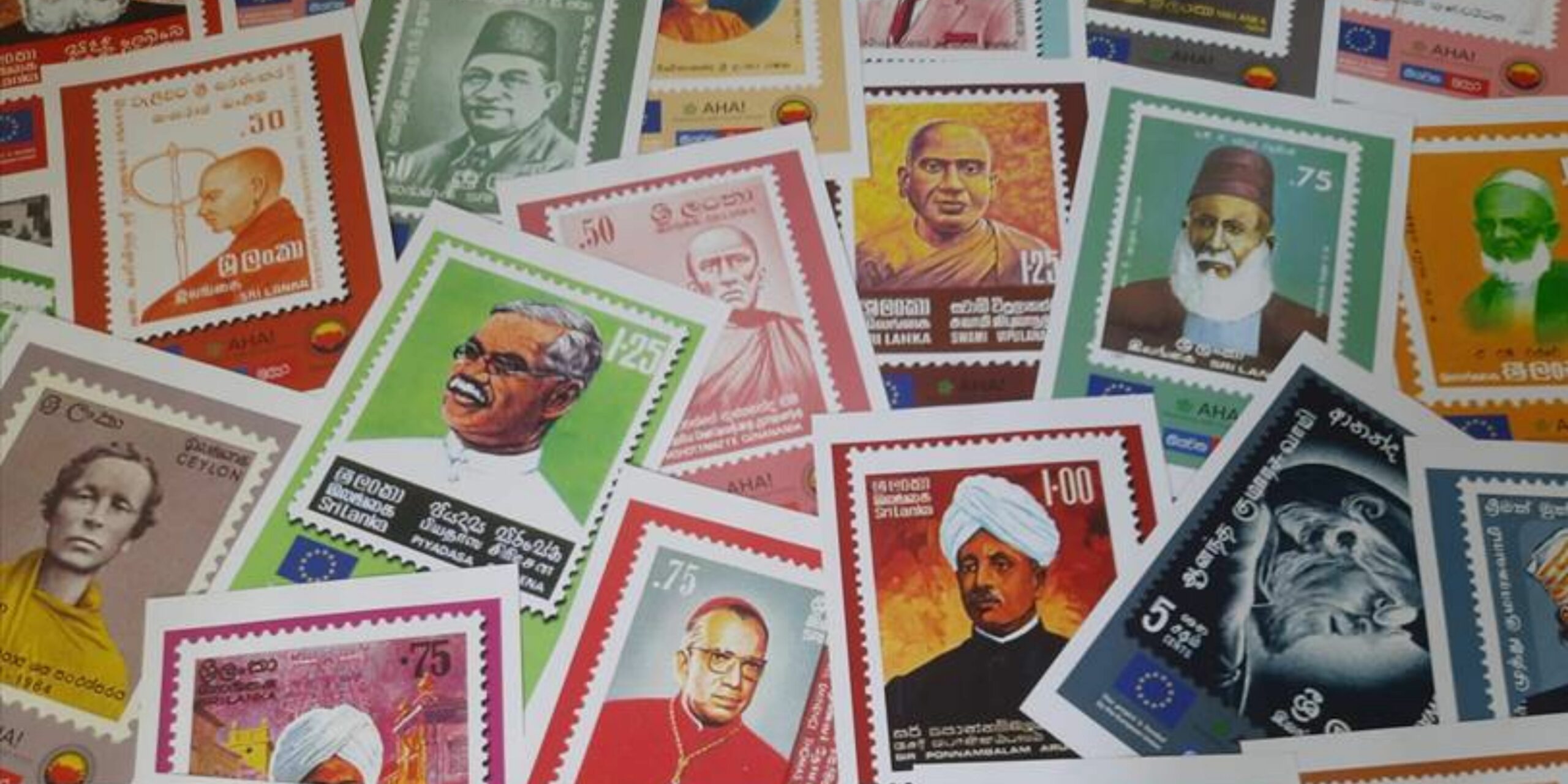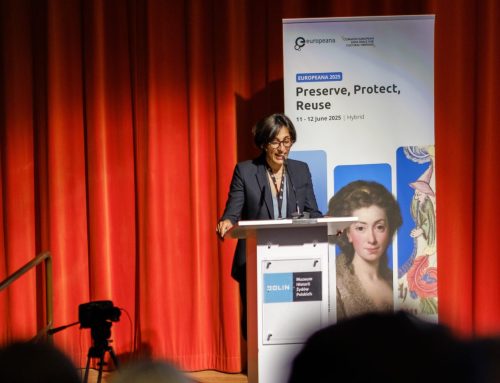On the 24th of August, Niroshana Peiris, Dennis Röder and Susanne Popp hosted a workshop on the use of postage stamps as visual historical sources. The workshop included an approach to promote historical competencies in history lessons and is part of a workshop series on creative teaching methodologies in history education. Future workshops will include topics such as the use of graphic novels in history education, music as a historical source and the use of counterfactual history. The workshop series forms part of the initiative 'History that Connects – Sri Lanka', a partnership between Strengthening Reconciliation Processes in Sri Lanka (SRP) of the Deutsche Gesellschaft für Internationale Zusammenarbeit (GIZ) and EuroClio, in cooperation with the International Society for History Didactics.
The use of postage stamps was established worldwide in the second half of the 19th century, during the time frame of imperialism and colonialism. Although postage stamps have been around for quite some time, the use of stamps in history education is relatively new and unexplored. This blogpost will provide insights into the use of stamps in history education.
Identity politics on a stamp
The beginning of the workshop was kicked off by introducing the most important features when looking at stamps. These include the name of the issuing nation, the denomination of the monetary value and the design and colour of the stamps. It's often the case that persons, events or symbols are depicted that symbolize national traditions and values. Therefore, stamps are usually used by governments as effective tools of national identity-building. Similar to coins, stamps are widely used on a daily basis, but most people are unaware of the messages that are spread with the use of stamps. As stamps are the official accounts of governments, they play a role in how the nation wants to portray itself or its past. It is the invention of identity and tradition on one piece of stamp.
A twofold use of stamps in history lessons
The workshop introduced two options of reading stamps as visual historical sources in history lessons. Firstly, the stamp's picture can be used to illustrate historical topics. Visual impressions help students to better memorize historical topics. Additionally, students are able to recognise that the topic of the history lesson plays a role in the contemporary history culture of a country. The second option to use stamps in history lessons is to read stamps as a visual historical source for the time of the emission of the stamp. Students can analyse the history culture of the time of the emission of the stamps, and this will help students to become aware of culture of remembrance. It also helps students acquire skills they can use in their daily lives to analyse messages of the history culture around them. It will similarly deepen students' methodological competences of visual source analysis. In sum, both the historical event that is depicted on the stamp as well as the publication date of the stamp are two angles that can be explored during a history lesson.
Checklist: four steps to work with stamps as visual sources in history education
What stood central in the workshop was the explanation of a guideline on how to work with stamps as visual sources. The checklist is not limited to the use of stamps as visual sources, but it can be used with other visual sources as well. The following steps and guiding questions will help you to empower your didactical decisions in the classroom, when analysing visual sources with your students.
Step 1. Give students time to formulate their first perception of the picture: encourage students to think about their individual perceptions of the picture, as this activates their prior knowledge. Give students the space to freely express their associations and to ask questions about the topic. After this, you collect the first information about the stamp, such as text, monetary value, format, size and colours.
Step 2. Let the students describe the picture: they should try to describe as detailed as possible what they recognize in the picture when they look at it more closely. For example, identity the representation technique (photo, drawing, painting), identify major and smaller elements of the picture (people, places, objects, symbols), pay attention to the way how they are represented (e.g. gestures, facial expressions, postures), describe the major features of the arrangement of the picture (center/periphery, background/foreground) and the colour scheme.
Step 3. Students will analyse the picture as a visual source.
Students can make use of the following guiding questions when analysing the content of the picture:
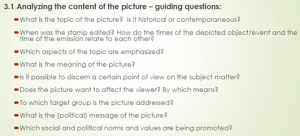
It is important to look at the year the stamp was published, and the historical event that is depicted on the stamp. Students can reflect on how these times are related. The example below shows how the time of emission and the time of the depicted historical event are related:
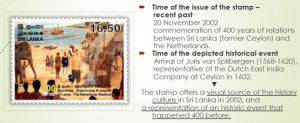
Additionally, students can collect additional information regarding the political or social context of the stamp, by making use of the following guiding questions:
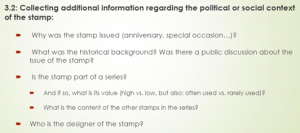
When looking at the value of the stamp, it is not automatically the case that the most important event or message is related to the highest monetary value of the stamp. It is often that the lowest valued stamp portrays the most important message or the highest ranked person. This is the case because low value stamps are used on a daily basis so the message will be more widespread.
Moreover, students can analyse what kind of picture is depicted on the stamp, and how that relates to the date of emission of the stamp.
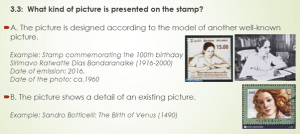
Step 4. The students interpret and evaluate the stamp as a document of the history, culture and governmental identity policies at the time of its emission. Which conclusions can the students draw? What is the main message behind the stamp? Students can make use of the following questions:
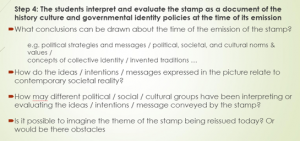
Suggestions and creative ideas for the use of visual sources in history lessons
A general remark on the use of stamps in the classroom is that stamps can be used throughout different phases in the lesson; for the introduction of a topic, for deepening historical thinking or methodological 'training' or even during examinations. The workshop concluded with a few suggestions on how to use stamps in history lessons:
- Compare a historical event and the representation of it on stamps. You can even compare several stamps on the same historical event.
- Use stamps for lessons about topics such as history culture, remembrance culture, the use and misuse of history, invented traditions or idendentity policies.
- Use a complete series of stamps: how did it change? A symbol can be used differently in the 50s, in 60s or even now. Students can explore continuity and change in the history culture.
- Look at a whole stamp set with the same emission date, from the smallest to the highest value. You can explore the selection and the attribution of value; which stamp was the most popular with which depiction? Which image was attributed the highest value?
- Use blank stamps for the students to create a stamp (series) related to a curricular topic. Which persons and events should be depicted in which way? Which symbols could be used and why?
Want to learn more about creative teaching methodologies for history lessons? Coming Saturday 25 September from 12:30 – 2:30 CEST, another workshop is hosted on the topic. This time the workshop will include a methodology on how to use storytelling and graphic novels in the classroom. You can register to join the online workshop here: https://us02web.zoom.us/meeting/register/tZIvd–qqT4tH9yLK7mpEqEHvLik1xWMvAy5

